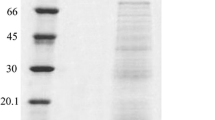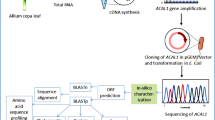Abstract
The recently reported Dendrobium findleyanum agglutinin (DFA) was identified and determined in different parts of D. findleyanum pseudobulbs by using Western blot analysis, LC–MS/MS, sodium dodecyl sulfate polyacrylamide gel electrophoresis (SDS-PAGE) and histochemical procedure. Western blot analysis of crude protein extract with horseradish peroxidase (HRP), a mannose-rich glycoprotein, showed only one band at 14.5 kDa, which had the same molecular mass as DFA. This band was a major band when the membrane was stained with Coomassie Brilliant Blue. The protein profiles from SDS-PAGE showed higher band intensity of the 14.5 kDa mannose-binding protein in nearly mature and mature stages, compared to very young and young stages of the orchid. In addition, the band intensity was to a great extent different between the swollen and the non-swollen internode of the pseudobulb. Using LC–MS/MS, the sequence tags of the 14.5-kDa protein bands from the node, swollen internode and non-swollen internode revealed that the protein was DFA. Histochemical procedure in the transverse section of the pseudobulbs demonstrated major HRP binding sites, which reflected the location of DFA, in periphery of parenchymal cells. The purified DFA showed anti-fungal activity against Alternaria alternata and Collectotrichum sp. Using reverse transcription polymerase chain reaction and DNA sequencing, the deduced amino acid sequence of the DFA precursor revealed 94% homology with a lectin precursor from D. officinale. N-terminal sequencing demonstrated the processing site between residues 24 and 25 of the DFA precursor.








Similar content being viewed by others
References
Barre A, Bourne Y, Van Damme EJM, Peumans WJ, Rouge P (2001) Mannose-binding plant lectins: different structural scaffolds for a common sugar-recognition process. Biochimie 83:645–651. doi:10.1016/S0300-9084(01)01315-3
Bekesiova I, Nap JP, Mlynarova L (1999) Isolation of high quality DNA and RNA from leaves of the carnivorous plant Drosera rotundifolia. Plant Mol Biol Rep 17:269–277. doi:10.1023/A:1007627509824
Bradford MM (1976) A rapid and sensitive method for the quantitation of microgram quantities of protein utilizing the principle of protein-dye binding. Anal Biochem 72:248–254. doi:10.1016/0003-2697(76)90527-3
Chen Z, Sun X, Tang K (2005a) Molecular cloning and characterization of mannose-binding lectin gene from Dendrobium officinale. J Plant Biochem Biotechnol 14:33–36
Chen Z, Sun X, Tang K (2005b) Cloning and expression of a novel cDNA encoding a mannose-binding lectin from Dendrobium officinale. Toxicon 45:535–540. doi:10.1016/j.toxicon.2004.12.019
Heth CA, Bernstein MH (1991) Mannose-sensitive HRP endocytosis by the retinal pigment epithelium. Exp Eye Res 52:75–82. doi:10.1016/0014-4835(91)90130-7
Holttum RE (1964) A revised flora of Malaya: an illustrated systematic account of the Malayan flora including commonly cultivated plants vol. I Orchid of Malaya, 3rd edn. The Government Printing Office, Singapore
Jiang JF, Han Y, Xing LJ, Xu YY, Xu ZH, Chong K (2006) Cloning and expression of a novel cDNA encoding a mannose-specific jacalin-related lectin from Oryza sativa. Toxicon 47:133–139. doi:10.1016/j.toxicon.2005.10.010
Laemmli UK (1970) Cleavage of structural proteins during the assembly of the head of bacteriophage T4. Nature 227:680–685. doi:10.1038/227680a0
Sharon N, Lis H (2004) History of lectins: from hemagglutinins to biological recognition molecules. Glycobiology 14:53R–62R. doi:10.1093/glycob/cwh122
Straus W (1981) Cytochemical detection of mannose-specific receptors for glycoproteins with horseradish peroxidase as a ligand. Histochemistry 73:39–47. doi:10.1007/BF00493131
Straus W (1983) Mannose-specific binding sites for horseradish peroxidase in various cells of rat. J Histochem Cytochem 31:78–81
Sudmoon R, Sattayasai N, Bunyatratchata W, Chaveerach A, Nuchadomrong S (2008) Thermostable mannose-binding lectin from Dendrobium findleyanum with activities dependent on sulfhydryl content. Acta Biochim Biophys Sin 40:811–818. doi:10.111/j.1745-7270.2008.00455.x
Vaessen RTMJ, Kreike J, Groot GSP (1981) Proteins transfer to nitrocellulose filters: a simple method for quantitation of single proteins in complex mixtures. FEBS Lett 124:193–196
Van Damme EJM, Allen AK, Peumans WJ (1987) Leaves of the orchid twayblade (Listera ovata) contain a mannose-specific lectin. Plant Physiol 85:566–569
Van Damme EJM, Smeets K, Torrekens S, Van Leuven F, Peumans WJ (1994) Characterization and molecular cloning of mannose-binding lectins from the Orchidaceae species Listera ovata, Epipactis helleborine and Cymbidium hybrid. Eur J Biochem 221:769–777. doi:10.1111/j.1432-1033.1994.tb18790.x
Van Damme EJM, Declercq N, Claessens F, Hemschoote K, Peeters B, Peumans WJ (1991) Molecular cloning and characterization of multiple isoforms of the snowdrop (Galanthus nivalis L.) lectin. Planta 186:35–43. doi:10.1007/BF00201495
Van Damme EJM, Peumans WJ, Barre A, Rouge P (1998) Plant lectins: a composite of several distinct families of structurally and evolutionary related proteins with diverse biological role. Crit Rev Plant Sci 17:575–692. doi:10.1080/07352689891304276
Von Heijne G (1986) A new method for predicting signal sequence cleavage sites. Nucleic Acids Res 11:4683–4690
Wang X, Bauw G, Van Damme EJ, Peumans WJ, Chen ZL, Van Montagu M, Angenon G, Dillen W (2001) Gastrodianin-like mannose-binding proteins: a novel class of plant proteins with antifungal properties. Plant J 25:651–661. doi:10.1046/j.1365-313x.2001.00999.x
Xu Q, Liu Y, Wang X, Gu H, Chen Z (1998) Purification and characterization of a novel anti-fungal protein from Gastrodia elata. Plant Physiol Biochem 36:899–905. doi:10.1631/jzus.B0820341
Acknowledgments
The authors are thankful for the financial support provided by the Thailand Research Fund through the Royal Golden Jubilee Ph.D. Program (Grant No. PHD/0015/2548) to R. Sudmoon and N. Sattayasai, and the Khon Kaen University’s Graduate Research Fund Academic year 2004. We also thank the staff of Bioservice Unit (BSU), National Science and Technology Development Agency (NSTDA), Thailand for protein identification using LC–MS/MS with database search and DNA sequencing, and the staff of Scientific Equipment Center, Prince of Songkla University, Thailand for N-terminal sequencing of protein.
Author information
Authors and Affiliations
Corresponding author
Additional information
Communicated by P. Kumar.
Rights and permissions
About this article
Cite this article
Sattayasai, N., Sudmoon, R., Nuchadomrong, S. et al. Dendrobium findleyanum agglutinin: production, localization, anti-fungal activity and gene characterization. Plant Cell Rep 28, 1243–1252 (2009). https://doi.org/10.1007/s00299-009-0724-0
Received:
Revised:
Accepted:
Published:
Issue Date:
DOI: https://doi.org/10.1007/s00299-009-0724-0




